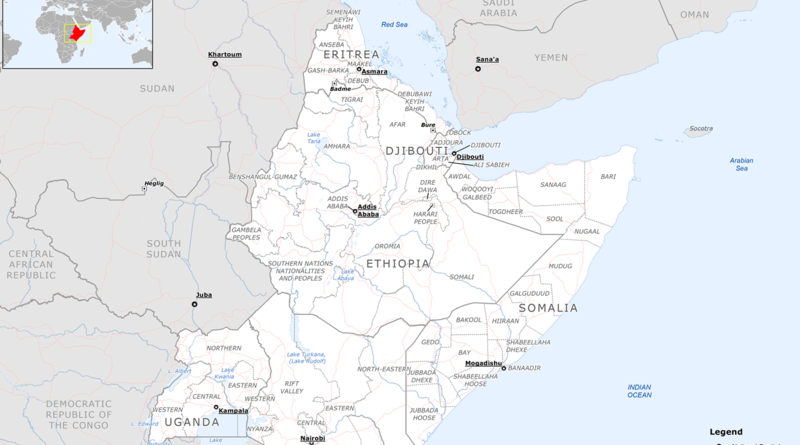What marks the Horn of Africa States? The first is its geographical location, its shape, and the component parts of the region. It is the easternmost region of the continent and comprises Somalia, Ethiopia, Eritrea, and Djibouti. It overlooks three major waterways that are vital for global trade and even for Aerospatiale activities. They are the northern Indian Ocean (the Somali Sea), the Gulf of Aden, and the Red Sea and it contains the major choke point of Bab El Mandab or the Gate of Tears, a barely 28 km stretch of water that links the Red Sea and the Gulf of Aden.
The Horn of Africa States is a geostrategic and violent region that has been in the news for the past 150 years and more, from the date the Suez Canal in Egypt was opened (1869). Colonial wars, wars of liberation, inter-state wars, and intra-state conflicts involving the complex traditional ethnic composition of the region, and determined and powerful external actors, pursuing their varied interests, have shaped the destiny of the region and kept it extremely volatile, hungry, and destitute for most of the years past.
It has remained markedly divided, unable to reaffirm its traditional highland/lowland cooperation, and sticks to the single-state infrastructures foreign parties have imposed on the region. The umbilical cords linking traditional sister cities of the past like Harar in Ethiopia and Zeila and Somalia or Assab in Eritrea and Mekelle in Ethiopia have been cut and remain unconnected. Mogadishu’s linkages to the Somali state in Ethiopia and the Oromia regions of Bale and other parts of Ethiopia like Sidamo have been cut and remain disconnected. Although new centers have emerged to replace the old connections like Djibouti and Addis Ababa, or Berbera and Jigjiga, regional connections remain fragile and in disarray, unorganized, and only work out of current necessity as was determined by foreign interests during the past 150 years, but not out of deliberate plans and organization of the region. The French built the railway linking Addis Ababa to Djibouti to serve their own interests and not the region’s while the Berbera Corridor to Jigjiga is manifestly of the making of the UAE, to serve mostly its interests in the region.
Obviously, the interests of the many external actors in the region criss-cross each other, and at times clash and only the region suffers from these divergent interests. The key element missing in the current matrix remains to be the cooperation of the regional component parts, the SEED countries. This has given to worries of some of the important countries such as Ethiopia, which sees itself as the hegemon of the region without reaping the benefits of a hegemon. Ethiopia sees itself as the largest country with the largest population and the largest economy but deprived of a sea outlet. It had always had access through Mogadishu, Berbera, Zeila, Assab, Massawa, and others throughout history, and was never denied access to the sea, although it never owned access to any sea in the past. It is unlikely this would happen in the future either and the best way, perhaps, would be to organize a regional platform, which integrates the economies of the region and where all the parties cooperate and collaborate, just like other regions of the world.
The East Africa Community, the Southern Africa Development Community, and ECOWAS should be great examples to emulate where there are coastal countries and hinterland countries that do not threaten their coastal neighbors within the same geographical proximities. Perhaps, the recent pronouncements from Ethiopia on the matter of access to a sea were misunderstood but if otherwise, then Ethiopia should revisit its thought processes and should heed making announcements that do not add to the need for regional cooperation. It would only add to its frustrations.
The countries of the region should not forget the historical amities and enmities of the countries of the region. One should not stir a band of fire ants but should address the challenges of the region including its economic integration, dealing with regional neighbors such as those across the sea in Arabia or neighboring African regions like the EAC or foreign powers that have come from distant lands because of the geostrategic significance of the region.
The region should be taking advantage of the opportunities at hand when most of the world’s powers appear to have a need to have a presence in the region. It is truly an opportune time to work together and present itself as a collective to help in the negotiation processes with those countries. Working together is always more efficient and more beneficial than working on a single-state format as is the case at present. The frustrations with respect to access to a sea would certainly disappear and the countries of the region would be working through unity in diversity.
There is no doubt that the region would, down the road, work on an integrated economic infrastructure and on a geostrategic collective basis when it comes to dealing with non-regional parties. The region is currently undergoing a difficult transition period as Somalia is barely recovering from a fragile state, Eritrea remains isolated and perhaps out of sync with any party, Djibouti is too tiny economically and geographically and survives through providing maritime services to others, while Ethiopia, the largest country in the region is still engaged in ethnic violence and hence the apparent frustrations. It is, indeed, a difficult transition period for the region but it should emerge in due course as a powerful regional block that takes advantage of its rich heritage, regional wealth, and extremely significant waterways, both riverine and marine.

